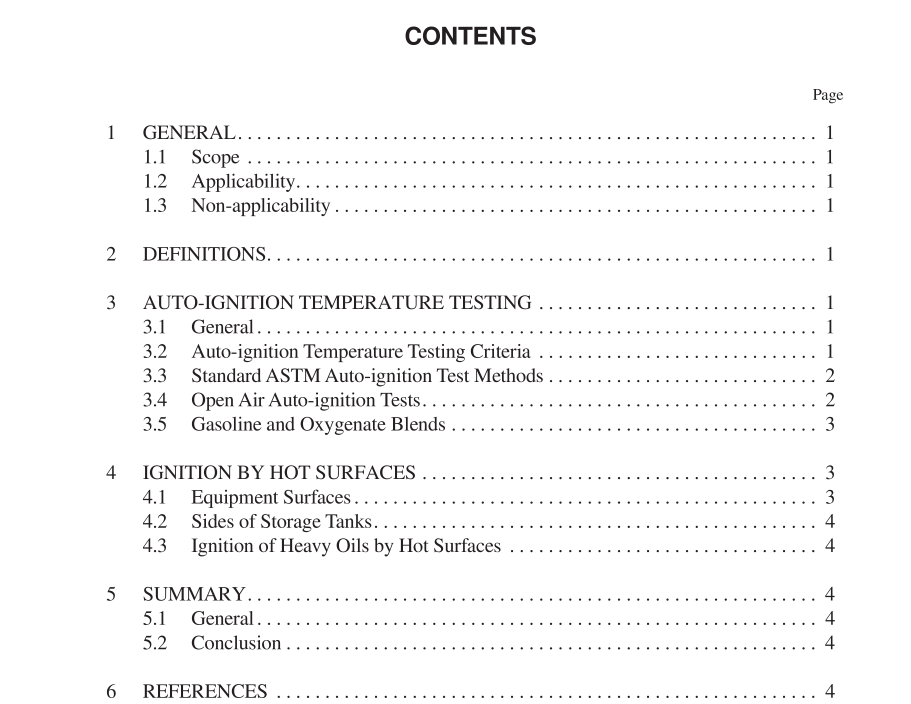API RP 2216 pdf download

API RP 2216 pdf download.Ignition Risk of Hydrocarbon Liquids and Vapors by Hot Surfaces in the Open Air
1.1 SCOPE
This recommended practice provides information concern- ing the potential for ignition of hydrocarbons that are exposed to hot surfaces in the open air. Hydrocarbon liquids, when heated sufficiently, can ignite without the application of a flame or spark. The ignition of hydrocarbons by hot surfaces may occur when oil is released under pressure and sprays on a hot surface or is spilled and lies on a hot surface for a period of time. Understanding the mechanism and dynamics of auto- ignition is an important step in preventing or controlling the ignition of hydrocarbons by hot surfaces in the open air. In addition to the information provided herein, appropriate industry standards and other information may assist users to understand the potential hazards of hydrocarbon auto-ignition (such as spontaneous combustion) not specifically covered by this publication and implement appropriate prevention and control measures.
1.2 APPLICABILITY
Hot surfaces, in areas where hydrocarbon liquids or vapors are present and may be released, are often presumed to be the sources of ignition should fires occur. However, it is generally recognized by the petroleum industry that hot surfaces, even at temperatures considerably above the auto-ignition temper- atures (AIT) of the hydrocarbons involved, are not always capable of igniting flammable vapor-in-air mixtures. This publication provides information applicable to the better understanding and controlling of hot surface ignition hazards.
1.3 NON-APPLICABILITY
This recommended practice does not cover every possible hazard or situation that may involve ignition of hydrocarbon liquids and vapors from hot surfaces. This publication does not apply to the ignition of hydrocarbons when certain condi- tions occur, such as spontaneous combustion (see 2.2). The mechanism for spontaneous combustion is entirely different from that required for ignition of hydrocarbon vapors from contact with hot surfaces in open air. This publication also does not apply to the ignition of hydrocarbon vapors when contacted by heated or glowing metal such as welding slag or by direct impact of super-hot exhaust fumes or gases. In addi- tion, this publication does not cover ignitions arising from hydrocarbon liquids trapped behind rust or oil soaked or satu- rated insulation or rust covering hot surfaces.
3.1 GENERAL
This recommended practice covers the technical basis for the risk of ignition of hydrocarbons by hot surfaces based on AIT and the practical implications thereof. An understanding of AIT is important when hydrocarbon vapors or liquids are exposed to hot surfaces or when handling very hot hydrocar- bon liquids. It should be understood that ignition of flamma- ble hydrocarbon vapors by a hot surface at the minimum ignition temperatures (for the specific hydrocarbon) is not likely. Experimental studies, testing and practical experience have shown that hot surfaces must typically be hundreds of degrees above published minimum ignition temperatures to ignite freely moving hydrocarbon vapor in the open air. Even properly operating automotive vehicle catalytic exhaust sys- tems, in most instances, do not create a surface temperature sufficiently high enough to ignite hydrocarbon vapors in the open air 2 . Whether or not flames will develop when a hydro- carbon contacts a hot surface depends not only on the surface temperature, but also on the extent (size) of the hot surface, its geometry and the ambient conditions 3 . The following information, covering AIT research, is intended to assist in understanding why the ignition of hydro- carbon vapors by hot surfaces (at published minimum AITs), is highly improbable.









